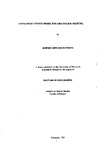A STRATEGIC CHOICE MODEL FOR ASIA-PACIFIC SHIPPING
| dc.contributor.author | HAWKINS, JEFFREY EDWARD | |
| dc.contributor.other | Faculty of Science and Engineering | en_US |
| dc.date.accessioned | 2013-09-19T12:57:01Z | |
| dc.date.available | 2013-09-19T12:57:01Z | |
| dc.date.issued | 1997 | |
| dc.identifier | NOT AVAILABLE | en_US |
| dc.identifier.uri | http://hdl.handle.net/10026.1/1890 | |
| dc.description.abstract |
The importance of strategy to an organisation's competitiveness is widely acknowledged in the strategic management literature. However, although strategy research has become substantial in other areas, the same cannot be said with the shipping industry. Very littie is known about how shipowners choose competitive strategies or what strategies they pursue under certain environmental conditions. Of what is available, most focus on Northern Europe and Northem America, with scant regard for the Asia-Pacific, which has become a major shipping power in recent decades. This study was, therefore, conducted to address these gaps in the literature. It analysed the strategic choices made by Asia-Pacific shipowners at the corporate level, compared actual shipowners' behaviour with strategic management theory on strategy selection, and developed a strategy selection model that was applicable to Asia-Pacific shipowners and consistent with strategic management theory. An extensive review of the literature was initially undertaken to develop a generic strategic choice model, which then served as the basis upon which information from Asia-Pacific shipowners was collected. A multi-method approach, called triangulation, was used to guide data collection and analysis. Data was obtained from two sources (shipowners' representatives and shipping experts) and through several methods (mail survey, interviews, simulation, expert and document review), and the extent to which these various sets of data were congruent had to be established. Because of the exploratory nature of the study, data was analysed using a qualitative approach. There was a high degree of congruence in the data collected. Out of the analysis, two primary findings emerged: (1) there was strong support for the strategic choice model, which implied greater inter-industry applicability than originally expected; (2) however, modifications to the model were needed to reflect a general tendency among Asia-Pacific shipowners to use other strategies in combination with or as a substitute to those offered by the model. | en_US |
| dc.language.iso | en | en_US |
| dc.publisher | University of Plymouth | en_US |
| dc.title | A STRATEGIC CHOICE MODEL FOR ASIA-PACIFIC SHIPPING | en_US |
| dc.type | Thesis | |
| plymouth.version | Full version | en_US |
| dc.identifier.doi | http://dx.doi.org/10.24382/4692 |
Files in this item
This item appears in the following Collection(s)
-
01 Research Theses Main Collection
Research Theses Main


